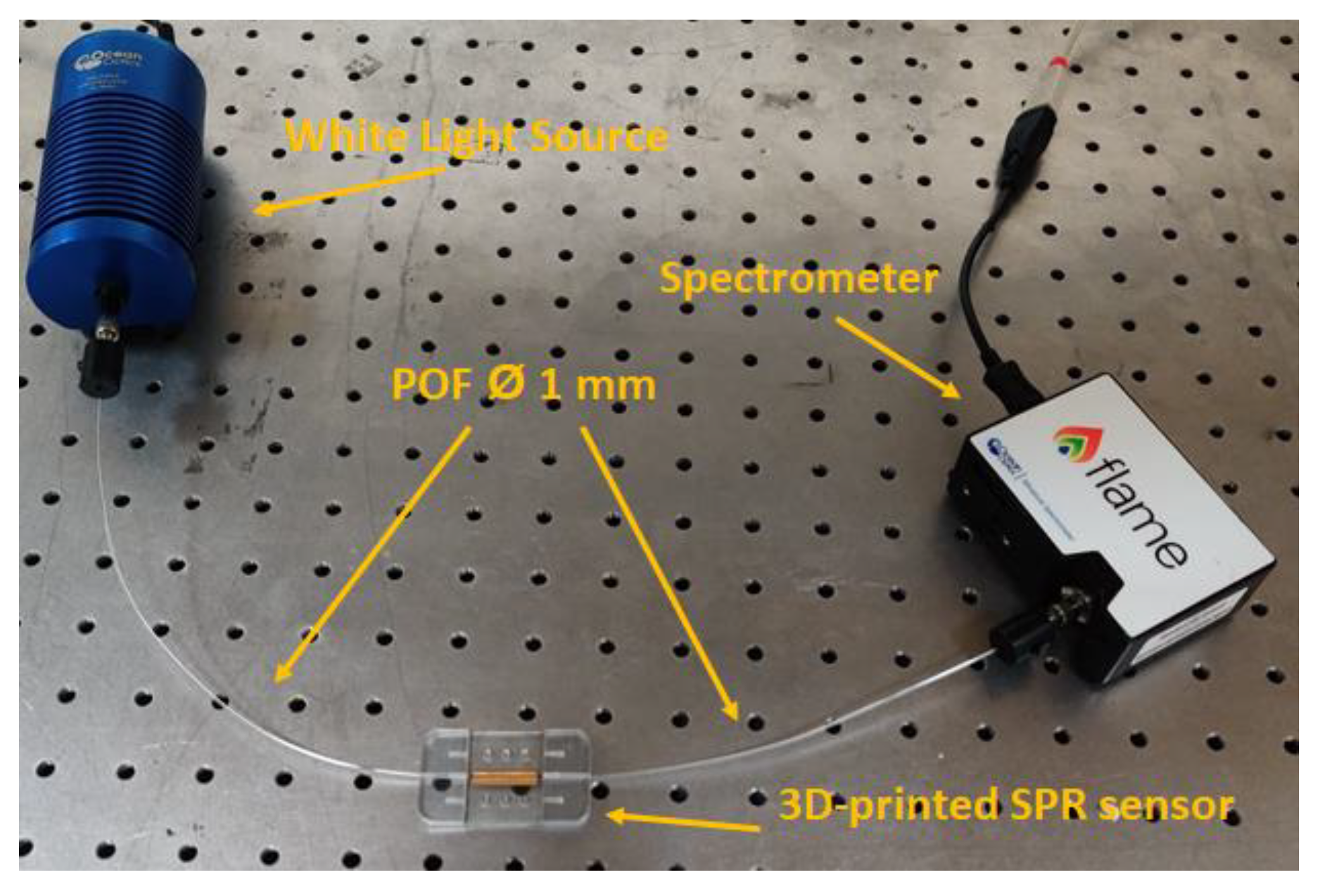Surface Plasmon Resonance Sensor Based on Inkjet 3D Printing †
Abstract
:1. Introduction
2. 3D-Printed Surface Plasmon Resonance Sensor
2.1. SPR Sensor Design and Fabrication
2.2. Experimental Setup
3. Results
3.1. Experimental Results
3.2. Cost Analysis
4. Conclusions
Author Contributions
Funding
Institutional Review Board Statement
Informed Consent Statement
Data Availability Statement
Acknowledgments
Conflicts of Interest
References
- Barshilia, D.; Chau, L.-K.; Chang, G.-E. Low-cost planar waveguide-based optofluidic sensor for real-time refractive index sensing. Opt. Express 2020, 28, 27337–27345. [Google Scholar] [CrossRef] [PubMed]
- Lončar, M.; Doll, T.; Vučković, J.; Scherer, A. Design and Fabrication of Silicon Photonic Crystal Optical Waveguides. J. Light. Technol. 2000, 18, 1402. [Google Scholar] [CrossRef] [Green Version]
- De Kerf, T.; Pipintakos, G.; Zahiri, Z.; Vanlanduit, S.; Scheunders, P. Identification of Corrosion Minerals Using Shortwave Infrared Hyperspectral Imaging. Sensors 2022, 22, 407. [Google Scholar] [CrossRef]
- Tong, L.; Wei, H.; Zhang, S.; Xu, H. Recent Advances in476 Plasmonic Sensors. Sensors 2014, 14, 7959–7973. [Google Scholar] [CrossRef] [PubMed] [Green Version]
- Haring, A.P.; Khan, A.U.; Liu, G.; Johnson, B.N. 3D Printed Functionally Graded Plasmonic Constructs. Adv. Opt. Mater. 2017, 5, 1700367. [Google Scholar] [CrossRef]
- Garcìa-Astrain, C.; Lenzi, E.; De Aberasturi, D.J.; Henriksen-Lacey, M.; Binelli, M.R.; Liz-Marzaàn, L.M. 3D-Printed Biocompatible Scaffolds with Built-In Nanoplasmonic Sensors. Adv. Funct. Mater. 2020, 30, 2005407. [Google Scholar] [CrossRef]
- Xu, Y.; Wu, X.; Guo, X.; Kong, B.; Zhang, M.; Qian, X.; Mi, S.; Sun, W. The Boom in 3D-Printed Sensor Technology. Sensors 2017, 17, 1166. [Google Scholar] [CrossRef] [PubMed]
- Forrest, S. The path to ubiquitous and low-cost organic electronic appliances on plastic. Nature 2004, 428, 911–918. [Google Scholar] [CrossRef] [PubMed]
- Lambert, A.; Valiulis, S.; Cheng, Q. Advances in Optical Sensing and Bioanalysis Enabled by 3D Printing. ACS Sens. 2018, 3, 2475–2491. [Google Scholar] [CrossRef] [PubMed]
- Hinman, S.S.; McKeating, K.S.; Cheng, Q. Plasmonic Sensing with 3D Printed Optics. Anal. Chem. 2017, 89, 12626–12630. [Google Scholar] [CrossRef] [PubMed] [Green Version]
- Prajzler, V.; Kulha, P.; Knietel, M.; Enser, H. Large core plastic planar optical splitter fabricated by 3D printing technology. Opt. Commun. 2017, 400, 38–42. [Google Scholar] [CrossRef]
- Cennamo, N.; Saitta, L.; Tosto, C.; Arcadio, F.; Zeni, L.; Fragalá, M.E.; Cicala, G. Microstructured Surface Plasmon Resonance Sensor Based on Inkjet 3D Printing Using Photocurable Resins with Tailored Refractive Index. Polymers 2021, 13, 2518. [Google Scholar] [CrossRef] [PubMed]
- Cennamo, N.; Massarotti, D.; Conte, L.; Zeni, L. Low Cost Sensors Based on SPR in a Plastic Optical Fiber for Biosensor Implementation. Sensors 2011, 11, 11752–11760. [Google Scholar] [CrossRef] [PubMed]






Publisher’s Note: MDPI stays neutral with regard to jurisdictional claims in published maps and institutional affiliations. |
© 2021 by the authors. Licensee MDPI, Basel, Switzerland. This article is an open access article distributed under the terms and conditions of the Creative Commons Attribution (CC BY) license (https://creativecommons.org/licenses/by/4.0/).
Share and Cite
Saitta, L.; Cennamo, N.; Tosto, C.; Arcadio, F.; Fragalà, M.E.; Zeni, L.; Cicala, G. Surface Plasmon Resonance Sensor Based on Inkjet 3D Printing. Eng. Proc. 2021, 11, 39. https://doi.org/10.3390/ASEC2021-11127
Saitta L, Cennamo N, Tosto C, Arcadio F, Fragalà ME, Zeni L, Cicala G. Surface Plasmon Resonance Sensor Based on Inkjet 3D Printing. Engineering Proceedings. 2021; 11(1):39. https://doi.org/10.3390/ASEC2021-11127
Chicago/Turabian StyleSaitta, Lorena, Nunzio Cennamo, Claudio Tosto, Francesco Arcadio, Maria Elena Fragalà, Luigi Zeni, and Gianluca Cicala. 2021. "Surface Plasmon Resonance Sensor Based on Inkjet 3D Printing" Engineering Proceedings 11, no. 1: 39. https://doi.org/10.3390/ASEC2021-11127
APA StyleSaitta, L., Cennamo, N., Tosto, C., Arcadio, F., Fragalà, M. E., Zeni, L., & Cicala, G. (2021). Surface Plasmon Resonance Sensor Based on Inkjet 3D Printing. Engineering Proceedings, 11(1), 39. https://doi.org/10.3390/ASEC2021-11127









